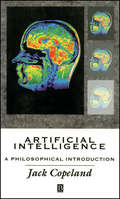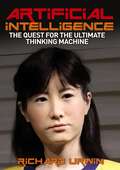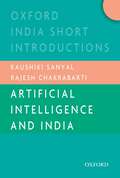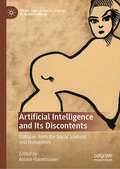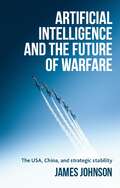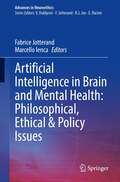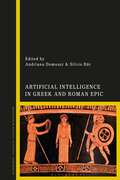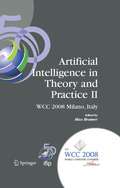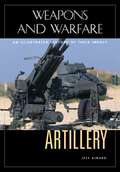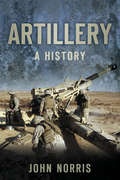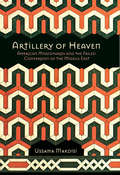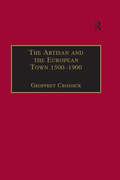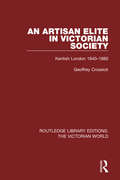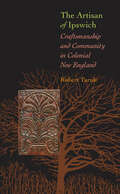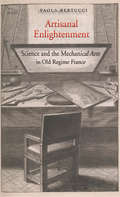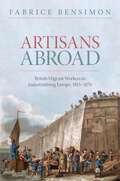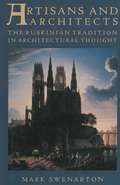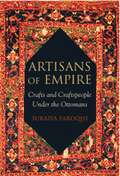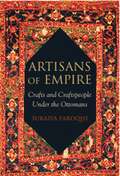- Table View
- List View
Artificial Intelligence: A Philosophical Introduction
by Jack CopelandPresupposing no familiarity with the technical concepts of either philosophy or computing, this clear introduction reviews the progress made in AI since the inception of the field in 1956. Copeland goes on to analyze what those working in AI must achieve before they can claim to have built a thinking machine and appraises their prospects of succeeding. There are clear introductions to connectionism and to the language of thought hypothesis which weave together material from philosophy, artificial intelligence and neuroscience. John Searle's attacks on AI and cognitive science are countered and close attention is given to foundational issues, including the nature of computation, Turing Machines, the Church-Turing Thesis and the difference between classical symbol processing and parallel distributed processing. The book also explores the possibility of machines having free will and consciousness and concludes with a discussion of in what sense the human brain may be a computer.
Artificial Intelligence: A Philosophical Introduction
by Jack CopelandPresupposing no familiarity with the technical concepts of either philosophy or computing, this clear introduction reviews the progress made in AI since the inception of the field in 1956. Copeland goes on to analyze what those working in AI must achieve before they can claim to have built a thinking machine and appraises their prospects of succeeding. There are clear introductions to connectionism and to the language of thought hypothesis which weave together material from philosophy, artificial intelligence and neuroscience. John Searle's attacks on AI and cognitive science are countered and close attention is given to foundational issues, including the nature of computation, Turing Machines, the Church-Turing Thesis and the difference between classical symbol processing and parallel distributed processing. The book also explores the possibility of machines having free will and consciousness and concludes with a discussion of in what sense the human brain may be a computer.
Artificial Intelligence: The Quest for the Ultimate Thinking Machine
by Richard UrwinWhat is Artificial Intelligence (AI)? What can it do and how is it created? In this highly accessible guide to the subject, Richard Urwin bases his assessment of AI on the definition of AI as a tool that is 'constructed to aid or substitute for human thought'. He explains how AI came about, the importance of the development of the computer and then examines how AI has developed over the years through the construction of computer programs and how the language used to construct these programs has become more and more sophisticated, thus allowing AI to become better and better. Along the way, you will discover numerous intriguing examples of how scientists have progressed the development of AI, learn about Fuzzy Logic and the ups and downs of computer programming, as well as finding out how research into brain function is continually influencing the field of AI. By turns fascinating and scary, Artificial Intelligence will take the reader on an amazing journey that covers everything from the habits of ants to the world of the stock market.
Artificial Intelligence and India (Oxford India Short Introductions)
by Kaushiki Sanyal Rajesh ChakrabartiWhat is artificial intelligence (AI)? How did it evolve over the years and what is it going to look like in the future? What are the opportunities and risks associated with AI? Where does India stand among the global AI ecosystems? This book answers these questions and gives a bird's-eye view of the field of AI, with a special focus on India. In clear, jargon-free language it explains what is and, more importantly, what is not AI. It provides a well-rounded summary of the ongoing debates on ethics, regulation, bias, and data privacy surrounding the development and use of AI technology. Using up-to-date data, the book looks at India's contributions to and adoption of AI, as the country has a significant stake in the AI revolution as one of the fastest growing economies.
Artificial Intelligence and Its Discontents: Critiques from the Social Sciences and Humanities (Social and Cultural Studies of Robots and AI)
by Ariane HanemaayerOn what basis can we challenge Artificial Intelligence (AI) - its infusion, investment, and implementation across the globe? This book answers this question by drawing on a range of critical approaches from the social sciences and humanities, including posthumanism, ethics and human values, surveillance studies, Black feminism, and other strategies for social and political resistance. The authors analyse timely topics, including bias and language processing, responsibility and machine learning, COVID-19 and AI in health technologies, bio-AI and nanotechnology, digital ethics, AI and the gig economy, representations of AI in literature and culture, and many more. This book is for those who are currently working in the field of AI critique and disruption as well as in AI development and programming. It is also for those who want to learn more about how to doubt, question, challenge, reject, reform and otherwise reprise AI as it been practiced and promoted.
Artificial intelligence and the future of warfare: The USA, China, and strategic stability
by James JohnsonThis volume offers an innovative and counter-intuitive study of how and why artificial intelligence-infused weapon systems will affect the strategic stability between nuclear-armed states. Johnson demystifies the hype surrounding artificial intelligence (AI) in the context of nuclear weapons and, more broadly, future warfare. The book highlights the potential, multifaceted intersections of this and other disruptive technology – robotics and autonomy, cyber, drone swarming, big data analytics, and quantum communications – with nuclear stability. Anticipating and preparing for the consequences of the AI-empowered weapon systems are fast becoming a critical task for national security and statecraft. Johnson considers the impact of these trends on deterrence, military escalation, and strategic stability between nuclear-armed states – especially China and the United States. The book draws on a wealth of political and cognitive science, strategic studies, and technical analysis to shed light on the coalescence of developments in AI and other disruptive emerging technologies. Artificial intelligence and the future of warfare sketches a clear picture of the potential impact of AI on the digitized battlefield and broadens our understanding of critical questions for international affairs. AI will profoundly change how wars are fought, and how decision-makers think about nuclear deterrence, escalation management, and strategic stability – but not for the reasons you might think.
Artificial intelligence and the future of warfare: The USA, China, and strategic stability
by James JohnsonThis volume offers an innovative and counter-intuitive study of how and why artificial intelligence-infused weapon systems will affect the strategic stability between nuclear-armed states. Johnson demystifies the hype surrounding artificial intelligence (AI) in the context of nuclear weapons and, more broadly, future warfare. The book highlights the potential, multifaceted intersections of this and other disruptive technology – robotics and autonomy, cyber, drone swarming, big data analytics, and quantum communications – with nuclear stability. Anticipating and preparing for the consequences of the AI-empowered weapon systems are fast becoming a critical task for national security and statecraft. Johnson considers the impact of these trends on deterrence, military escalation, and strategic stability between nuclear-armed states – especially China and the United States. The book draws on a wealth of political and cognitive science, strategic studies, and technical analysis to shed light on the coalescence of developments in AI and other disruptive emerging technologies. Artificial intelligence and the future of warfare sketches a clear picture of the potential impact of AI on the digitized battlefield and broadens our understanding of critical questions for international affairs. AI will profoundly change how wars are fought, and how decision-makers think about nuclear deterrence, escalation management, and strategic stability – but not for the reasons you might think.
Artificial Intelligence in Brain and Mental Health: Philosophical, Ethical & Policy Issues (Advances in Neuroethics)
by Fabrice Jotterand Marcello IencaThis volume provides an interdisciplinary collection of essays from leaders in various fields addressing the current and future challenges arising from the implementation of AI in brain and mental health. Artificial Intelligence (AI) has the potential to transform health care and improve biomedical research. While the potential of AI in brain and mental health is tremendous, its ethical, regulatory and social impacts have not been assessed in a comprehensive and systemic way. The volume is structured according to three main sections, each of them focusing on different types of AI technologies. Part 1, Big Data and Automated Learning: Scientific and Ethical Considerations, specifically addresses issues arising from the use of AI software, especially machine learning, in the clinical context or for therapeutic applications. Part 2, AI for Digital Mental Health and Assistive Robotics: Philosophical and Regulatory Challenges, examines philosophical, ethical and regulatory issues arising from the use of an array of technologies beyond the clinical context. In the final section of the volume, Part 3 entitled AI in Neuroscience and Neurotechnology: Ethical, Social and Policy Issues, contributions examine some of the implications of AI in neuroscience and neurotechnology and the regulatory gaps or ambiguities that could potentially hamper the responsible development and implementation of AI solutions in brain and mental health. In light of its comprehensiveness and multi-disciplinary character, this book marks an important milestone in the public understanding of the ethics of AI in brain and mental health and provides a useful resource for any future investigation in this crucial and rapidly evolving area of AI application. The book is of interest to a wide audience in neuroethics, robotics, computer science, neuroscience, psychiatry and mental health.
Artificial Intelligence in Greek and Roman Epic
by Andriana Domouzi and Silvio BärThis is the first scholarly exploration of concepts and representations of Artificial Intelligence in ancient Greek and Roman epic, including their reception in later literature and culture. Contributors look at how Hesiod, Homer, Apollonius of Rhodes, Moschus, Ovid and Valerius Flaccus crafted the first literary concepts concerned with automata and the quest for artificial life, as well as technological intervention improving human life.Parts one and two consider, respectively, archaic Greek, and Hellenistic and Roman, epics. Contributors explore the representations of Pandora in Hesiod, and Homeric automata such as Hephaestus' wheeled tripods, the Phaeacian king Alcinous' golden and silver guard dogs, and even the Trojan Horse. Later examples cover Artificial Intelligence and automation (including Talos) in the Argonautica of Apollonius and Valerius Flaccus, and Pygmalion's ivory woman in Ovid's Metamorphoses. Part three underlines how these concepts benefit from analysis of the ekphrasis device, within which they often feature. These chapters investigate the cyborg potential of the epic hero and the literary implications of ancient technology. Moving into contemporary examples, the final chapters consider the reception of ancient literary Artificial Intelligence in contemporary film and literature, such as the Czech science-fiction epic Starvoyage, or Small Cosmic Odyssey by Jan Kr?esadlo (1995) and the British science-fiction novel The Holy Machine by Chris Beckett (2004).
Artificial Intelligence in Greek and Roman Epic
This is the first scholarly exploration of concepts and representations of Artificial Intelligence in ancient Greek and Roman epic, including their reception in later literature and culture. Contributors look at how Hesiod, Homer, Apollonius of Rhodes, Moschus, Ovid and Valerius Flaccus crafted the first literary concepts concerned with automata and the quest for artificial life, as well as technological intervention improving human life.Parts one and two consider, respectively, archaic Greek, and Hellenistic and Roman, epics. Contributors explore the representations of Pandora in Hesiod, and Homeric automata such as Hephaestus' wheeled tripods, the Phaeacian king Alcinous' golden and silver guard dogs, and even the Trojan Horse. Later examples cover Artificial Intelligence and automation (including Talos) in the Argonautica of Apollonius and Valerius Flaccus, and Pygmalion's ivory woman in Ovid's Metamorphoses. Part three underlines how these concepts benefit from analysis of the ekphrasis device, within which they often feature. These chapters investigate the cyborg potential of the epic hero and the literary implications of ancient technology. Moving into contemporary examples, the final chapters consider the reception of ancient literary Artificial Intelligence in contemporary film and literature, such as the Czech science-fiction epic Starvoyage, or Small Cosmic Odyssey by Jan Kr?esadlo (1995) and the British science-fiction novel The Holy Machine by Chris Beckett (2004).
Artificial Intelligence in Theory and Practice II: IFIP 20th World Computer Congress, TC 12: IFIP AI 2008 Stream, September 7-10, 2008, Milano, Italy (IFIP Advances in Information and Communication Technology #276)
by Max BramerThe papers in this volume comprise the refereed proceedings of the conference ‘ Artificial Intelligence in Theory and Practice’ (IFIP AI 2008), which formed part of the 20th World Computer Congress of IFIP, the International Federation for Information Processing (WCC-2008), in Milan, Italy in September 2008. The conference is organised by the IFIP Technical Committee on Artificial Intelligence (Technical Committee 12) and its Working Group 12.5 (Artificial Intelligence Applications). All papers were reviewed by at least two members of our Program Committee. Final decisions were made by the Executive Program Committee, which comprised John Debenham (University of Technology, Sydney, Australia), Ilias Maglogiannis (University of Aegean, Samos, Greece), Eunika Mercier-Laurent (KIM, France) and myself. The best papers were selected for the conference, either as long papers (maximum 10 pages) or as short papers (maximum 5 pages) and are included in this volume. The international nature of IFIP is amply reflected in the large number of countries represented here. The conference also featured invited talks by Prof. Nikola Kasabov (Auckland University of Technology, New Zealand) and Prof. Lorenza Saitta (University of Piemonte Orientale, Italy). I should like to thank the conference chair, John Debenham for all his efforts and the members of our program committee for reviewing papers to a very tight deadline.
Artillery: An Illustrated History of Its Impact (Weapons and Warfare)
by Jeff KinardAddressing its technical evolution as well as its military and social impact, this comprehensive reference shows how historic leaders such as Dionysus of Syracuse, the Ottoman sultan Mohammad II, Oliver Cromwell, and Napoleon Bonaparte were successful in battle because of their innovative use of artillery.Artillery: An Illustrated History of Its Impact charts the development of large, crew-operated battlefield weapons from the dart firers and catapults of the ancient world to the invention of gunpowder in China and its applications in medieval Europe, and from the emergence of naval and land gunnery four centuries ago to the latest rapid-fire, rocket propulsion, laser guidance, and antiaircraft technologies.Written by an expert on military history, Artillery explores the technological and strategic innovations that have made these weapons increasingly effective at breaking through fortifications, inflicting casualties from a safe distance, providing cover for advancing forces, demoralizing opponents, and defending positions from attack. Beyond the battlefield, the book also looks at the impact of artillery on history and on the lives of civilians as well as soldiers.
Artillery of Heaven: American Missionaries and the Failed Conversion of the Middle East (The United States in the World)
by Ussama MakdisiThe complex relationship between America and the Arab world goes back further than most people realize. In Artillery of Heaven, Ussama Makdisi presents a foundational American encounter with the Arab world that occurred in the nineteenth century, shortly after the arrival of the first American Protestant missionaries in the Middle East. He tells the dramatic tale of the conversion and death of As'ad Shidyaq, the earliest Arab convert to American Protestantism. The struggle over this man's body and soul—and over how his story might be told—changed the actors and cultures on both sides. In the unfamiliar, multireligious landscape of the Middle East, American missionaries at first conflated Arabs with Native Americans and American culture with an uncompromising evangelical Christianity. In turn, their Christian and Muslim opponents in the Ottoman Empire condemned the missionaries as malevolent intruders. Yet during the ensuing confrontation within and across cultures an unanticipated spirit of toleration was born that cannot be credited to either Americans or Arabs alone. Makdisi provides a genuinely transnational narrative for this new, liberal awakening in the Middle East, and the challenges that beset it.By exploring missed opportunities for cultural understanding, by retrieving unused historical evidence, and by juxtaposing for the first time Arab perspectives and archives with American ones, this book counters a notion of an inevitable clash of civilizations and thus reshapes our view of the history of America in the Arab world.
The Artisan and the European Town, 1500–1900 (Historical Urban Studies Series)
by Geoffrey CrossickArtisans played a central role in the European town as it developed from the Middles Ages onwards. Their workshops were at the heart of productive activity, their guilds were often central to the political and legal order of towns, and their culture helped shape civic ritual and the urban order. These essays, which have all been specially written for this collection, explore the relationships between artisans and their towns across Europe between the beginning of the early-modern period and the end of the 19th century. They pay special attention to the processes of economic, juridicial and political change that have made the 18th and early 19th centuries a period of such significance. Written by leading historians of European artisans, the essays question the myths about artisans that have long pervaded research in the field. The leading myth was that shared by the artisans themselves - the myth of decline and the belief in each generation that artisans in the past had inhabited a better age. These essays open up for debate the nature of artisanship, the way economic change affected craft production, the political role of artisans, the cultural identification of the artisans with work and masculinity, and the way changing urban society and changing urban structure posed threats to which the artisans had to respond.
The Artisan and the European Town, 1500–1900 (Historical Urban Studies Series)
by Geoffrey CrossickArtisans played a central role in the European town as it developed from the Middles Ages onwards. Their workshops were at the heart of productive activity, their guilds were often central to the political and legal order of towns, and their culture helped shape civic ritual and the urban order. These essays, which have all been specially written for this collection, explore the relationships between artisans and their towns across Europe between the beginning of the early-modern period and the end of the 19th century. They pay special attention to the processes of economic, juridicial and political change that have made the 18th and early 19th centuries a period of such significance. Written by leading historians of European artisans, the essays question the myths about artisans that have long pervaded research in the field. The leading myth was that shared by the artisans themselves - the myth of decline and the belief in each generation that artisans in the past had inhabited a better age. These essays open up for debate the nature of artisanship, the way economic change affected craft production, the political role of artisans, the cultural identification of the artisans with work and masculinity, and the way changing urban society and changing urban structure posed threats to which the artisans had to respond.
An Artisan Elite in Victorian Society: Kentish London 1840-1880 (Routledge Library Editions: The Victorian World)
by Geoffrey CrossickFirst published in 1978. Mid-Victorian Britain was relatively stable in comparison with the turbulent period that preceded it, and that stability is in part explained by the emergence of an artisan elite with a specific relationship to the society around it. This book examines that elite: its clubs and societies, co-operatives and building societies; its values and ideology, challenging the notion that these artisans directly absorbed middle-class values; its politics, tracing the evolution from Chartism through the Reform League and on to a radical liberalism which existed in constant tension with the local liberal middle class. A careful reconstruction of the social, political and industrial life of these artisans is set within the context of the local communities, and their understanding of the mid-Victorian society in which they lived is seen as the explanation for their values and activities. This title makes a major contribution towards our understanding of the nineteenth-century working class.
An Artisan Elite in Victorian Society: Kentish London 1840-1880 (Routledge Library Editions: The Victorian World)
by Geoffrey CrossickFirst published in 1978. Mid-Victorian Britain was relatively stable in comparison with the turbulent period that preceded it, and that stability is in part explained by the emergence of an artisan elite with a specific relationship to the society around it. This book examines that elite: its clubs and societies, co-operatives and building societies; its values and ideology, challenging the notion that these artisans directly absorbed middle-class values; its politics, tracing the evolution from Chartism through the Reform League and on to a radical liberalism which existed in constant tension with the local liberal middle class. A careful reconstruction of the social, political and industrial life of these artisans is set within the context of the local communities, and their understanding of the mid-Victorian society in which they lived is seen as the explanation for their values and activities. This title makes a major contribution towards our understanding of the nineteenth-century working class.
The Artisan of Ipswich: Craftsmanship and Community in Colonial New England
by Robert TaruleThomas Dennis emigrated to America from England in 1663, settling in Ipswich, a Massachusetts village a long day's sail north of Boston. He had apprenticed in joinery, the most common method of making furniture in sixteenth- and seventeenth-century Britain, and he became Ipswich's second joiner, setting up shop in the heart of the village. During his lifetime, Dennis won wide renown as an artisan. Today, connoisseurs judge his elaborately carved furniture as among the best produced in seventeenth-century America.Robert Tarule, historian and accomplished craftsman, brilliantly recreates Dennis's world in recounting how he created a single oak chest. Writing as a woodworker himself, Tarule vividly portrays Dennis walking through the woods looking for the right trees; sawing and splitting the wood on site; and working in his shop on the chest—planing, joining, and carving. Dennis inherited a knowledge of wood and woodworking that dated back centuries before he was born, and Tarule traces this tradition from Old World to New. He also depicts the natural and social landscape in which Dennis operated, from the sights, sounds, and smells of colonial Ipswich and its surrounding countryside to the laws that governed his use of trees and his network of personal and professional relationships.Thomas Dennis embodies a world that had begun to disappear even during his lifetime, one that today may seem unimaginably distant. Imaginatively conceived and elegantly executed, The Artisan of Ipswich gives readers a tangible understanding of that distant past.
Artisanal Enlightenment: Science and the Mechanical Arts in Old Regime France
by Paola BertucciA groundbreaking work that places the mechanical arts and the world of making at the heart of the Enlightenment What would the Enlightenment look like from the perspective of artistes, the learned artisans with esprit, who presented themselves in contrast to philosophers, savants, and routine-bound craftsmen? Making a radical change of historical protagonists, Paola Bertucci places the mechanical arts and the world of making at the heart of the Enlightenment. At a time of great colonial, commercial, and imperial concerns, artistes planned encyclopedic projects and sought an official role in the administration of the French state. The Société des Arts, which they envisioned as a state institution that would foster France’s colonial and economic expansion, was the most ambitious expression of their collective aspirations. Artisanal Enlightenment provides the first in-depth study of the Société, and demonstrates its legacy in scientific programs, academies, and the making of Diderot and D’Alembert’s Encyclopédie. Through insightful analysis of textual, visual, and material sources, Bertucci provides a groundbreaking perspective on the politics of writing on the mechanical arts and the development of key Enlightenment concepts such as improvement, utility, and progress.
Artisans Abroad: British Migrant Workers in Industrialising Europe, 1815-1870
by Fabrice BensimonBetween 1815 and 1870, when European industrialisation was in its infancy and Britain enjoyed a technological lead, thousands of British workers emigrated to the continent. They played a key role in several sectors, like textiles, iron, mechanics, and the railways. These men and women thereby contributed significantly to the industrial take-off in continental Europe. Artisans Abroad examines the lives and trajectories of these workers who emigrated from manufacturing centres in Britain to France, Belgium, Germany, and other countries, considering their mobilities, their culture, their politics, and their relations with the local populations. Fabrice Bensimon reminds us that the British economy was not just oriented towards the Empire and the USA, but also towards the continent, long before the European Union and Brexit, and shows the critical role played by migrant workers in the Industrial Revolution. Artisans Abroad is the first social and cultural history of this forgotten migration.
Artisans Abroad: British Migrant Workers in Industrialising Europe, 1815-1870
by Fabrice BensimonBetween 1815 and 1870, when European industrialisation was in its infancy and Britain enjoyed a technological lead, thousands of British workers emigrated to the continent. They played a key role in several sectors, like textiles, iron, mechanics, and the railways. These men and women thereby contributed significantly to the industrial take-off in continental Europe. Artisans Abroad examines the lives and trajectories of these workers who emigrated from manufacturing centres in Britain to France, Belgium, Germany, and other countries, considering their mobilities, their culture, their politics, and their relations with the local populations. Fabrice Bensimon reminds us that the British economy was not just oriented towards the Empire and the USA, but also towards the continent, long before the European Union and Brexit, and shows the critical role played by migrant workers in the Industrial Revolution. Artisans Abroad is the first social and cultural history of this forgotten migration.
Artisans of Empire: Crafts and Craftspeople Under the Ottomans
by Suraiya FaroqhiThe manufacture and trade in crafted goods and the men and women who were involved in this industry - including metalworkers, ceramicists, silk weavers, fez-makers, blacksmiths and even barbers - lay at the social as well as the economic heart of the Ottoman empire. This comprehensive history by leading Ottoman historian Suraiya Faroqhi presents the definitive view of the subject, from the production and distribution of different craft objects to their use and enjoyment within the community.Succinct yet comprehensive, "Artisans of Empire" analyses the production and trade of crafts from the beginning of the 16th century to the early 20th century, focusing on its history, politics and culture. Production methods, the organisation of trade guilds, religious differences, the contribution of women and the structure of the Ottoman economy all come under scrutiny in this wide-ranging history that combines keen analysis with descriptions of the beautiful and sometimes unknown works of Ottoman artisans. Faroqhi sheds new light on all aspects of artisan life, setting the concerns of individual craftsmen within the context of the broader cultural themes that connect them to the wider world.Combining social, cultural, economic, religious and historiographical insights, this will be the authoritative work on Ottoman artisans and guilds for many years to come.
Artisans of Empire: Crafts and Craftspeople Under the Ottomans (Library Of Ottoman Studies #20161030)
by Suraiya FaroqhiThe manufacture and trade in crafted goods and the men and women who were involved in this industry - including metalworkers, ceramicists, silk weavers, fez-makers, blacksmiths and even barbers - lay at the social as well as the economic heart of the Ottoman empire. This comprehensive history, by leading Ottoman historian Suraiya Faroqhi, presents the definitive view of the subject, from the production and distribution of different craft objects to their use and enjoyment within the community. Faroqhi sheds new light on all aspects of artisan life, setting the concerns of individual craftsmen within the context of the broader cultural themes that connect them to the wider world. Combining social, cultural, economic, religious and historical insights, this will be the authoritative work on Ottoman artisans and guilds for many years to come.'A display of unrivalled knowledge of the sources by one of the leading historians of the Ottoman Empire.' - Erik J. Zürcher, Professor of Turkish Studies at the University of Leiden
